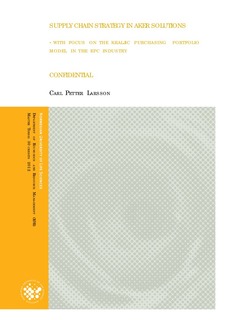| dc.description.abstract | The Master Thesis is completed in cooperation with Aker Engineering & Technology’s Supply Chain business area, a part of Aker Solutions ASA. The company delivers fully integrated onshore and offshore facilities to oil companies worldwide. The Supply Chain unit of Aker Engineering & Technology is specialized in the procurement of equipment items. In order to meet the market competition of this business the company is constantly developing its strategies in terms of possible ways to ensure a sustained competitive advantage.
The thesis statement is related to how Aker Solutions can establish a higher competitive advantage by carrying out strategic moves in terms of the purchased equipment in the projects. The purpose has been to find different ways to establish information sources and planning tools of the procurement strategy for future projects, by using an on-going project as a presumption. The academic purpose of this thesis is to contribute to extend the knowledge base of purchasing portfolio models. The thesis is based on purchasing portfolio modelling and transaction cost theory
The theory of transaction costs has been used as an underlying assumption for revealing the cost drivers in a purchasing organisation and towards the use of vertical integration as a possible future strategy.
The purchasing portfolio theories are based on Peter Kraljic’s model from 1983 for distinguishing and characterize different items. The model is a two dimensional matrix model of supply risk and profit impact.
The matrix is customized and created through qualitative half-structured interviews with key-personnel primary from management positions in the company. The intention of this was to recognize the company specifics and critical factors related to the purchasing in Engineering Procurement Construction-projects, also called EPC-projects, in the company. The established model was subsequently utilized through a questionnaire answered by senior buyers, which enabled matrix positioning of selected equipment items in the on-going Eldfisk 2/7S-project. An excel spreadsheet was also generated to enable further use of the company customized model.
The matrix yielded a model of the actual positions of the selected items. the model can, from a strictly theoretical point of view describe an outline in which direction Aker Engineering & Technology could benefit from in terms of future strategy. The evaluation either determine withholding or moving the item position, depending on where the item is positioned in the matrix, by utilizing different strategies.
The final conclusion of the thesis in terms of the statement argues for less complicated purchasing process when dealing with items with low supply risks and profit impact. It is also argued for active supplier development and possibly vertical integration strategy in high supply risk items. | no_NO |
